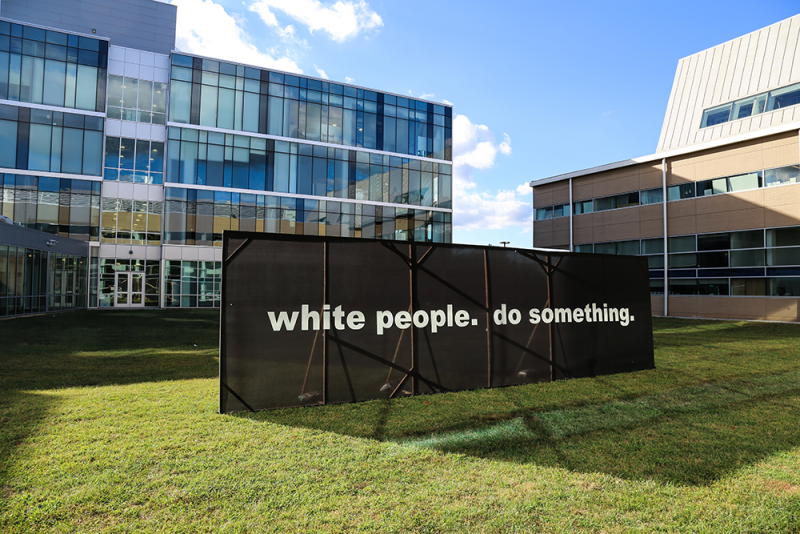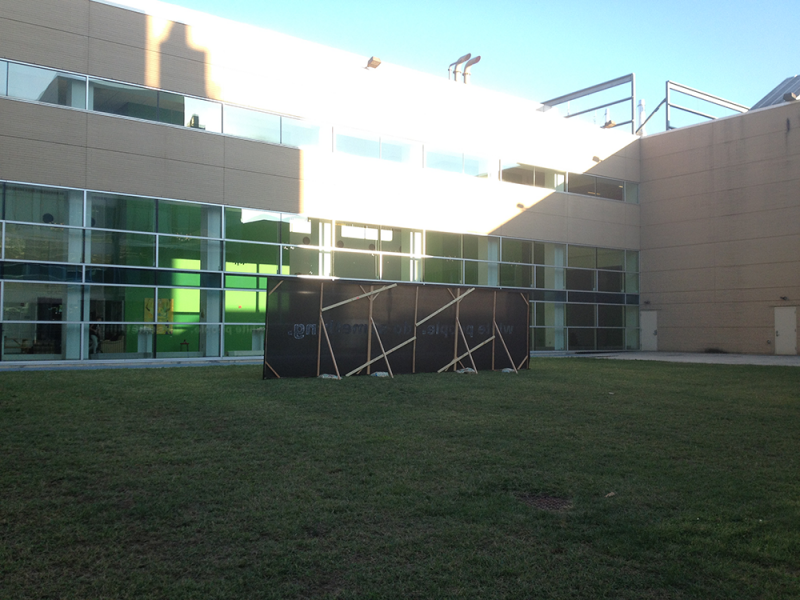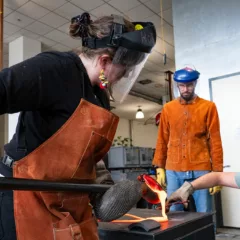

At last week’s art criticism panel Meredith Sellers shared that art writing for her is sometimes a means to work through the ideas and unravel those art pieces and shows that just get stuck in your brain. At the same time I have been working with my tongue to try to remove this popcorn kernel fragment that has been stuck in my craw all week. The perfect image for the feeling. I first saw Kara Springer’s piece on the internet via an Instagram post. It stayed in mind lodged there as an unmoved image, asking its question, doing its thing. It was still there when I was compelled to go see it in person two days later.
I should say that this stuckness comes from a distinct sort of annoyance. Annoyed at myself for being so annoyed. What are my reasons for being challenged? Working and communitizing around the visual arts, it’s easy to feel a numb sort of comfortable ease around art. That its touch, sight, feel, voice, is a familiar (yet exciting perhaps eccentric) relationship. In this sense, our art-as-an-armchair has become something like an oversized bean bag. But when an art piece grabs your attention it’s hard to ignore because it disrupts the languid comfortable homogeneity of my world and shows me something that doesn’t fit in; more specifically it actively refuses to fit in my world. That is how you know other worlds exist. This is how you get to those worlds. That is art at work.
Needless to say that Springer’s piece was/is doing all of the above. Here are some reasons:
- It’s hard to tell from the pictures that have been circulating on the internet but the art piece is placed in the courtyard directly facing the two story glassed-in “Green Hallway” promenade of the Tyler School of Art. This hallway makes for a great admissions tour but its 200 meter runway also forces a lot of drawn out awkward encounters. You basically have a 5 minute walk between seeing someone and actually meeting them. All of this is to say that going to Tyler means you will be spending a significant amount of time being exposed to this art piece. Also, if you are going to Tyler there is a good chance you are white. I say this matter-of-factly, because like almost every other art school in the country a majority of Tyler students identify as white. This context adds another interpretation to the art piece: white [art students/artists] people. do something.
- There is something here which is also pretty obvious. It’s 2016 and a lot of white people kinda still aren’t comfortable being called white. They’ve never been called it out loud. Have never said it out loud. I guess the idea is everyone else is a color except us?
- This piece has gained a lot of internet attention. Some of this attention has been negative. Reading the comments can be depressing but they help perspective. Some of this attention has been positive. Philadelphia’s own Streets Dept. is a good one. So is this one on AfroPunk.
- The art piece is also to the scale of an advertisement bill board. It makes you realize how often giant big words are usually meant to provoke consumer action not social action. It reignites the agitated Jenny Holzer poetic declarations that have been co-opted by “JUST DO IT” or “MAKE AMERICA GREAT AGAIN” (The fact that the statement is being made in all lowercase letters is maybe a rebuttal to that pumped up authoritarian voice.)
- As a white person, when I read “white people. do something.” my initial reaction is of course, “I’m already doing stuff! Lots of stuff!” Because in capitalist America the highest sin is always laziness, being unproductive. This is important because Springer’s piece asks–commands–something very specific of our racial stances. It calls not just for posturing but for action and by extension results. You may express liberal views but what direct change can you point to? Slacktivism is real. The results these words ask for are not large or specific. Do something, anything, this thing, that thing… It places the emphasis of the conversation on affecting change and not attitudes. And when you are asking for change what you are really asking for is: white people. where is your sacrifice?









